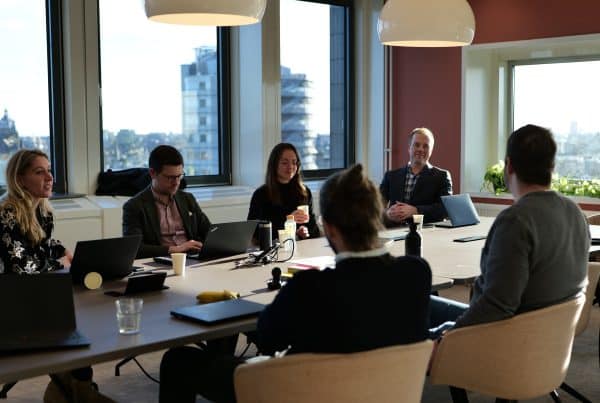New Economy and Amsterdam Data Collective have entered into an inspiring and ongoing conversation, discussing the potential role of governments and financial institutions in the transition to a more sustainable economy. What kind of data-driven strategies need to be incorporated to lead the way into a more robust and sustainable future? What opportunities will arise to accelerate your business ahead of the market? The decade of action is now. Ideally, this means combining efforts of decarbonizing on a global scale, while, at the same time, learning how to adapt to the consequences of the climate change that has already been ‘locked in’. To seriously start addressing climate change, therefore, requires both governments and corporations to fully integrate climate risk into all their systems and decision-making processes.
In general, the term ‘climate risk’ captures all risk that is induced by climate change and is often divided into physical and transition risk. Driven by their own challenges, integrating both these sides of climate risk into decision-making processes will require a thorough revision of how risk is currently quantified and implemented. Ultimately, both quantifying and mitigating climate risk will undeniably demand new and creative data-driven strategies but could also have the potential to lower costs and accelerate value growth.
Table of contents
Physical Risk from a Changing Climate
As global temperature rises and climates change, physical risk describes the potential physical effects. Increasingly disastrous wildfires, intense flooding and rising sea levels are just a selection of the hazardous physical risks that some areas have already experienced. In some cases, physical risk might still be somewhat predictable, as it can be measured when soil will soon become too dry or when dykes become inadequate. Mitigating physical risk, however, is considerably more difficult, as most systems and cities are designed in a way that they perform best within certain conditions. They can withstand strain and stresses within clear thresholds for certain periods of time. It is when conditions turn extreme, that physical risk becomes an undeniable problem.
For example, it might be possible to mitigate the risk of losing crop during a once-in-a-lifetime drought with a good insurance. But what are the possibilities for a farmer when these events occur more frequently? What if the same holds for extreme cold waves and typhoons? What prevents soil from becoming infertile for years? Past a certain point, abandoning old systems for completely new ones might even be the most cost-effective choice. To start anticipating on physical risk, it is thus necessary to look at the bigger picture, to prioritize and then shift communal focus towards the most daunting risks first. Therefore, it becomes crucial to fully understand the limits of current systems, the chances of breaching these limits and what the alternatives are.
Transition Risk from a Changing Climate
Interestingly, the actions taken to mitigate or limit physical risk often introduce an additional type of risk, induced by abrupt transitions. Transition risk describes all risks involved with the transition to more sustainable or resilient systems. It is human nature to assume some level of stability in their direct environment and to be ill-prepared for the most disastrous events. The increasing urgency of climate change on vulnerable systems then often results in hasty decisions, driven by the need of drastic change in a short period of time. The risk of transition is thus mostly driven by its abruptness and the associated inability of companies to adapt accordingly.
These abrupt transitions are mainly caused by strict regulatory changes (e.g. tax policy adjustments) or a sudden change in socioeconomic values. A government could decide to stop subsidising the meat industry and subsidise plant-based meat instead or, within the same time window, a change in cultural values can show a similar shift to meat replacement products. In either case, the meat industry will then clearly have a hard time to adapt its business model. The true impact of transition risk, however, intrudes much further. Packaging factories that used to package meat might be able to close a deal to package plant-based products instead. However, the producers of farm food will likely have a much harder time to switch their core business. In this way, transition risk can also trigger a domino effect that should also be considered. For example, if the farm food factory is forced to close, what will happen to the shops in the local town where all these factory workers live? This demonstrates the complex role transition risk can play in all kinds of businesses that are specialized and heavily dependent on a stable environment.
Integrating Climate Risk in Business
Both types of climate risk increase significantly for companies that are threatened by an unstable (socioeconomic) environment, that are highly specialized or have a high dependency on other companies. Presently, this describes almost all companies and sectors. Over the past decades, a steady increase in stability, globalisation, means of transportation and ways of communication has been the global trend. Understandably, this has resulted in an increasing ability to specialize, to complicate systems and to rely heavily on counterparties as well. Initially this might have been the goal, but at this point it has also made the world increasingly vulnerable to change. This global climate of low diversification and high dependency has cleared the stage for climate risk exposure.
Evidently, if the issue of climate risk is not integrated properly, physical risk of companies will increase over time until it results in disastrous bankruptcies. Alternatively, governments might step in and transition risk will cause similar results for unprepared companies. In other words, to secure their business, companies will have to start taking stock of their exposure to climate risk, limit this exposure and anticipate on its opportunities as soon as possible.
Redefining Risk Based on Climate Change
Across sectors there are all kinds of models that estimate various types of risk (e.g. credit risk, property risk, etc). Although even the best risk models do not describe reality, currently, some of them seem to come close and predict potential outcomes with very high precision. Therefore, it is not surprising that it has become the norm to rely heavily on these models. Most prediction models, however, estimate risk exposure mainly based on large historical data sets. This naturally imposes a blocking issue when attempting to predict any form of climate risk, as this is a historically almost unknown phenomenon. This inability to predict climate risk with a similar ease on top of a continued reliance on current risk models, has truly made climate risk such a pressing issue. Integrating climate risk will not just require additional risk models but it will even be necessary to redefine how risk is quantified today.
Scenario Analyses and Stress Testing
Currently, the preferred approach to quantifying climate risk is to develop complex and extensive scenario analyses. These analyses often provide several scenarios that are worth investigating, ranging from the best to the worst case. Focussing on just one of these (albeit an average or most likely case) would give an oversimplified view of the world and would not fully encompass its potential risk. A scenario analysis should investigate a clear potential hazard, carefully work out the set of feasible scenarios and then calculate the probability of each of these scenarios. Based on these probabilities and the choice of risk appetite, a decision can be made. For example, the chance of flooding in a certain area will have great impact on the estimations of both the true costs of building new real estate or the value of current housing. If done properly, an extensive set of complex scenarios can be formulated, which can be adjusted accordingly when new information has presented itself over time.
Furthermore, stress testing can be used to identify tail risk to get a better picture of the potential size that climate risk exposure could grow to. Stress testing is already used in different sectors to identify various limitations but could be explored further to raise awareness on the potential disastrous effects of climate risk. In other words, stress testing allows for pre-emptive action, which in most cases will also be substantially more cost efficient. Additionally, it allows governments and corporates to prepare for worst-case scenario risk, which is particularly useful for climate risk because of its irreversible nature.
Challenges Ahead in Quantifying Climate Risk
Apart from being a driver behind classical types of risk, climate risk will thus also pose a set of various new challenges. To summarize, climate risk is dissimilar from risks that has been modelled many times before, because it is not only global, but also unstable and historically unrecorded. The unavailability of historical data combined with its unstable nature will make it incredibly hard to predict climate risk exposure. Additionally, most climate risk will be unhedgeable, meaning that investors and asset owners will be exposed unless some system-wide action is taken to address the risks. Furthermore, as climate risk is happening on a global scale, its urgency is also slowly becoming more undeniable to everyone. Understandably, this can sound both alarming and motivating. Either way, climate risk is challenging everyone to stay ahead of the curve, which makes today the best time to start addressing it together.
Would you like to know more?
This is the first part in a series of articles that we have planned to publish on the topic of climate risk. In our next article, we will further discuss the potential role that the financial sector can play in addressing climate risk. After that, part three will focus on potential first steps that can be taken today. What are quick wins? What are the opportunities that we see for companies that seriously want to start addressing climate risk in their business decision processes? If you have any questions or need any assistance in setting up, reviewing, or even remodelling your current risk models, please contact Julia van Huizen of Amsterdam Data Collective, jvanhuizen@adc-consulting.com.






